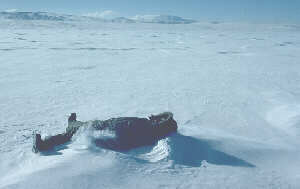Wind-blown Snow as a Water Resource
Research History
Summary of Small-scale Modeling Methods
In introducing this history section, we suggested that some of the
methods--and researchers--might be a little different. Crawling around on a
frozen lake in a ground blizzard (even a very gentle one) is not the cup of
tea preferred by most. But small-scale models can give quick, accurate
answers to questions about snowdrifts around complex objects, when conditions
are right. The most critical conditions are a very smooth surface (like lake
ice), wind speed just strong enough to start drifting of new snow (20-25 mph),
and accurate models.
What outdoor modelers gain is lots of the real material, snow, without the
expense of large cold rooms. However, they lack the control over wind speed
and direction, which wind tunnels provide. So one other condition critical
to accurate outdoor modeling is patience. Snowman Jairell is an expert at
recognizing (and waiting for) good modeling conditions.

 To Small-scale Models
To Small-scale Models


 To Small-scale Models
To Small-scale Models